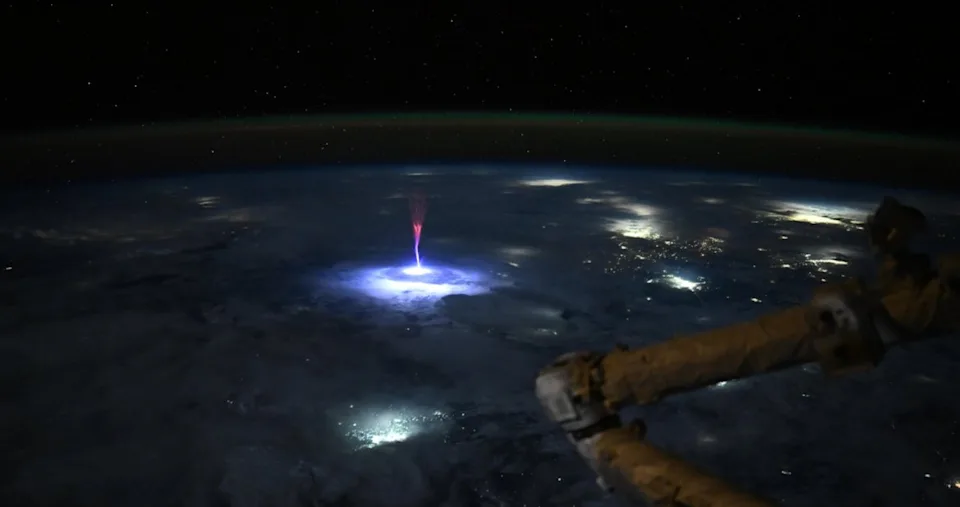Imagine looking out of a window 250 miles above Earth and witnessing a fleeting burst of light that looks like a cosmic firework.
That’s exactly what NASA astronaut Nichole “Vapor” Ayers experienced when she captured a breathtaking image of a rare red sprite from the International Space Station (ISS) on July 3, 2025.
This extraordinary photograph, taken as the ISS orbited over Mexico and the U.S., has taken the internet by storm, amassing over 2.7 million views on X.

Here’s everything you need to know about this mesmerizing atmospheric phenomenon and the astronaut who brought it to light.
What Are Red Sprites?
Red sprites are a type of Transient Luminous Event (TLE), brief but brilliant bursts of light that occur high above powerful thunderstorms, typically at altitudes between 31 and 56 miles in the mesosphere.
Unlike the lightning we see from the ground, sprites are cold plasma discharges, resembling gigantic jellyfish with their reddish glow and tree-like structure. They’re triggered by intense electrical activity in storm clouds below, but their exact formation remains a mystery to scientists.
Ayers described the moment perfectly on X: “Just. Wow. As we went over Mexico and the U.S. this morning, I caught this sprite. Sprites are TLEs or Transient Luminous Events, that happen above the clouds and are triggered by intense electrical activity in the thunderstorms below.”
Her image shows a bluish-white flash on the clouds with a vivid red column shooting upward, a rare sight that’s difficult to capture from Earth due to cloud cover.
Why This Image Matters
Sprites are not just visually stunning; they’re scientifically significant.
According to NASA, images like Ayers’ help researchers better understand the relationship between TLEs and thunderstorms. The ISS’s unique vantage point above the clouds provides an unparalleled view, allowing scientists to study the formation and characteristics of these elusive phenomena.
Other TLEs, such as blue jets, elves, and gigantic jets, also occur in the upper atmosphere, but sprites remain one of the most striking due to their vivid color and structure.
The scientific community is still unraveling why some lightning bolts trigger sprites while others don’t. Photos like Ayers’ contribute valuable data to this ongoing research, offering insights into atmospheric electricity and its impact on our planet’s upper atmosphere.
Meet Nichole “Vapor” Ayers: The Astronaut Behind the Lens
Nichole Ayers, a Lieutenant Colonel in the U.S. Air Force, is no stranger to high-stakes missions. Selected as part of NASA’s 2021 Astronaut Candidate Class, she launched as the pilot of NASA’s SpaceX Crew-10 mission on March 14, 2025, and is currently stationed aboard the ISS as part of Expedition 72 and 73.
A Colorado native, Ayers graduated from the U.S. Air Force Academy with a degree in mathematics and later earned a master’s in computational and applied mathematics from Rice University.
With over 1,400 flight hours in T-38 and F-22 Raptor aircraft, including 200 combat hours in Operation Inherent Resolve, Ayers brings a wealth of experience to her role as an astronaut.
Her passion for photography has also made her a standout on the ISS. In May 2025, Ayers shared a mesmerizing video of the northern lights, describing the process as “fishing” for the perfect shot.
Her sprite image is another testament to her skill, capturing a fleeting moment that has captivated millions.
The Bigger Picture: Space-Based Science
Ayers’ photograph isn’t just a beautiful image; it’s a reminder of the critical research conducted aboard the ISS. During her six-month mission, Ayers and her crew are performing hundreds of experiments, from studying material flammability to examining the effects of microgravity on the human body.
These efforts advance our understanding of science and pave the way for future space exploration, including NASA’s Artemis program.
The sprite image also highlights the power of space-based observations in studying Earth’s atmosphere. As NASA noted on X, “A view of lightning that’s nothing like what we see on the ground: crew observations and instruments on the
@Space_Station can help us better understand the behaviors of storms.” This perspective underscores the ISS’s role as a unique platform for environmental monitoring.
Why Sprites Fascinate Us
Sprites have long captured the imagination, with pilots reporting sightings as early as the 1950s. Their fleeting nature—lasting just a fraction of a second—makes them a challenge to study, but advancements in space-based cameras have made it easier to capture these phenomena.
Ayers’ image, with its vivid red and blue hues, offers a glimpse into a part of our atmosphere that most of us will never see firsthand.
The viral response to her post, with over 2.7 million views, reflects the public’s fascination with the cosmos. From the auroras to rare atmospheric events like sprites, these images remind us of the beauty and mystery of our planet and beyond.
Final Thoughts
Nichole “Vapor” Ayers’ photograph of a red sprite is more than a stunning visual—it’s a window into the wonders of our atmosphere and the power of space exploration.
As we celebrate this incredible moment, we’re reminded of the importance of scientific discovery and the unique perspective offered by astronauts aboard the ISS. Whether you’re a space enthusiast or simply awed by nature’s beauty, this image is a testament to the magic that happens when human curiosity meets the vastness of the universe.